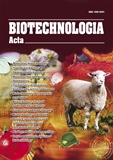ISSN 2410-7751 (Print)
ISSN 2410-776X (Online)

Biotechnologia Acta Т. 18, No. 2, 2025
P. 28-30 , Bibliography 9 , Engl.
UDC 577.1:615.277.3:612.017.1
doi: https://doi.org/10.15407/biotech18.02.028
Full text: (PDF, in English)
VIRTUAL SCREENING STRATEGY FOR IDENTIFYING NEW SMALL-MOLECULE ANTAGONISTS OF INTEGRIN αIIbβ3
O.A. Chuk
Palladin Institute of Biochemistry of the National Academy of Sciences of Ukraine, Kyiv.
Aim. To develop an optimal strategy for identifying new small-molecule antagonists of integrin αIIbβ3 using virtual screening.
Methods. Molecular modeling.
Results. The 7TMZ-based model demonstrated high classification accuracy (receiver operating characteristic area under the curve (ROC AUC): 84.285) and pose reproducibility (root mean square deviation (RMSD): 0.326 Å). The 3T3M-based model demonstrated high pose reproducibility (RMSD of 0.218 Å for RUC2 and 0.254 Å for RUC1).
Conclusions. Two virtual screening models were developed to identify integrin αIIbβ3 antagonists that do not induce receptor unfolding. Preliminary evaluation suggests their strong potential in selecting active compounds.
Keywords: virtual screening, small-molecule antagonists, integrin αIIbβ3, glycoprotein IIb/IIIa.
© Palladin Institute of Biochemistry of the National Academy of Sciences of Ukraine, 2025
References
1. Antoniucci, D. (2007). Differences among GP IIb/IIIa inhibitors: different clinical benefits
in non-ST-segment elevation acute coronary syndrome percutaneous coronary intervention
patients. European Heart Journal Supplements, 9 (suppl_A), A32–A36. https://doi.
org/10.1093/eurheartj/sul069
2. Hagemeyer, C. E., Peter, K. (2010). Targeting the platelet Integrin GPIIB/IIIA. Current
Pharmaceutical Design, 16(37), 4119–4133. https://doi.org/10.2174/138161210794519255
3. McClure, M. W., Berkowitz, S. D., Sparapani, R., Tuttle, R., Kleiman, N. S., Berdan, L. G.,
Lincoff, A. M., Deckers, J., …, Harrington, R. A. (1999). Clinical significance of
thrombocytopenia during a Non–ST-Elevation acute Coronary Syndrome. Circulation, 99(22),
2892–2900. https://doi.org/10.1161/01.cir.99.22.2892
4. Bougie, D. W., Rasmussen, M., Zhu, J., Aster, R. H. (2012). Antibodies causing
thrombocytopenia in patients treated with RGD-mimetic platelet inhibitors recognize ligandspecific
conformers of IIb/3 integrin. Blood. 119(26), 6317–6325. https://doi.org/10.1182/
blood-2012-01-406322
5. Cox, D. (2004). Oral GPIIB/IIIA antagonists: What went wrong? Current Pharmaceutical
Design. 10(14), 1587–1596. https://doi.org/10.2174/1381612043384673
6. Chew, D. P., Bhatt, D. L., Topol, E. J. (2001). Oral glycoprotein IIB/IIIA inhibitors. American
Journal of Cardiovascular Drugs, 1(6), 421–428. https://doi.org/10.2165/00129784-
200101060-00002
7. Lin, F., Li, J., Xie, Y., Zhu, J., Nguyen, T. T. H., Zhang, Y., Zhu, J., Springer, T. A. (2022).
A general chemical principle for creating closure-stabilizing integrin inhibitors. Cell, 185(19),
3533–3550.e27. https://doi.org/10.1016/j.cell.2022.08.008
8. Irwin, J. J., Shoichet, B. K., Mysinger, M. M., Huang, N., Colizzi, F., Wassam, P., Cao, Y.
(2009). Automated Docking Screens: A Feasibility study. Journal of Medicinal Chemistry,
52(18), 5712–5720. https://doi.org/10.1021/jm9006966

